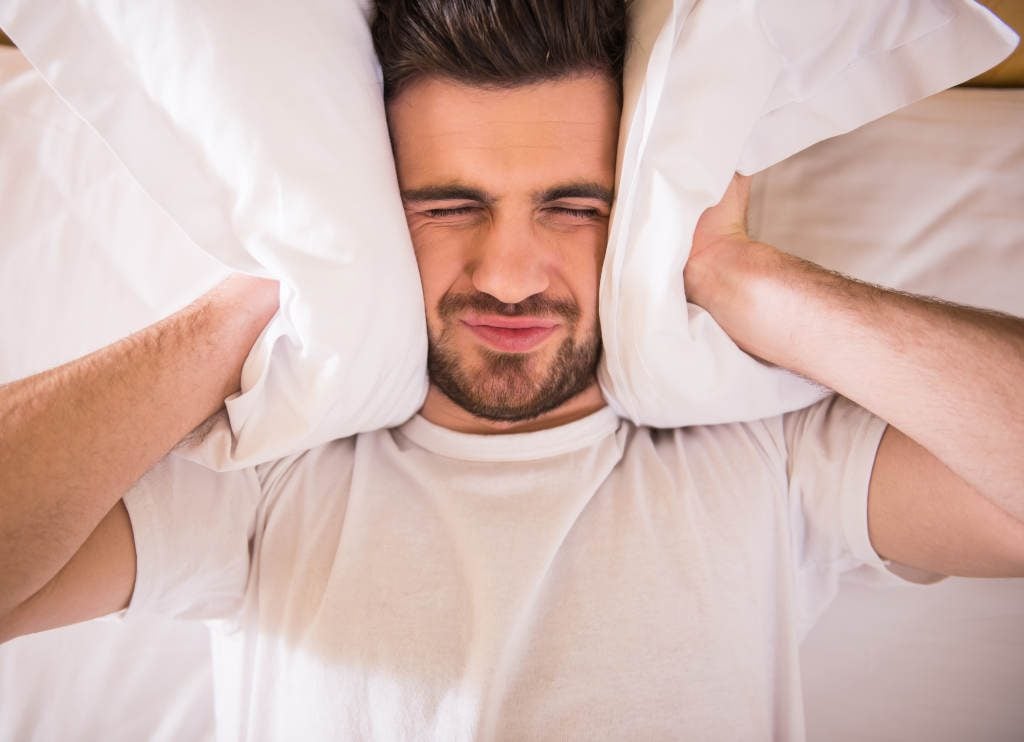
Foam earplugs are very effective at reducing noise across the whole frequency range.
Unfortunately, not everyone can tolerate foreign objects in their ear canal.
Other people like me, sometimes need or want to give their ears a break from earplugs without completely giving up on noise reduction when going to bed.
Others yet may be faced with noise that overpowers even the best earplugs.
There good news: There are some good alternatives to earplugs for blocking out noise so that you can sleep.
Some of these options work for side and back sleepers and some are only practical for back sleepers.
So let’s get right into it.
White Noise Machines
In several hospital studies, white noise machines have been shown to significantly improve sleep. They are amongst my all-time favorites for fending off nighttime noise.
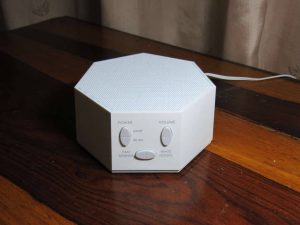
They produce a waterfall-like sound that masks disturbing environmental noise, so that you don’t hear it anymore, or, at the very least, so that your mind can ignore it.
Arousals, fragmented sleep, and awakenings are often caused by sudden, startling noises.
This is where white noise machines come in: They are so effective because they reduce the difference between background noise and suddenly occurring noises.
Noise masking works for a large variety of noises, including barking dogs, chatter and TV noise coming through the walls from neighboring rooms, traffic noise, and so on.
White noise machines are also among the most effective tools to get rid of repeatedly occurring, annoying sounds.
I have such a machine (the Lectrofan Classic) on my night table.
When shopping for a white noise machine, get one that allows you to adjust the pitch of the white noise to match your room and the types of noise you want mask. One white-noise setting is likely not going to be enough!
I want emphasize this point: If you want to mask a barking Rottweiler, a high-pitched sound or the crackling of a campfire isn’t going to do it. To match that kind of dog, your white noise needs enough substance in the bass frequencies.
You also want to be able to adjust the volume finely from very quiet to really loud. The Lectrofan allows you do to do this.
Alternatively, if you want the sound of a real fan, the Marpac Dohm Classic is a good choice for stationary use. Again, you can adjust the pitch of the fan with this machine.
Last, but not least, you can use white noise machines to improve the effectiveness of almost all noise reducing devices, including earmuffs and earplugs. So if you have tried foam or wax earplugs but find them not effective enough, add a white noise machine.
Moldable wax or silicone putty earplugs
If you can’t tolerate foam or triple flange earplugs in your ear canal, moldable earplugs are a good alternative for sleeping.
Unlike foam earplugs, which have to be inserted quite deep into the ear canal, these earplugs only seal the ear canal entrance. They are simply rolled into a ball, pressed against the ear and flattened.
![]()
So while you may feel them a tiny bit at first, you won’t experience any pressure in your ear.
What’s more, while not as effective as foam for low-frequency noise, moldable wax and silicone earplugs are very respectable noise blockers.
They typically have a noise reduction rating (NRR) of 22 to 23 dB. As to specific brands, Ohropax Classic (wax) and Mack’s Pillow Soft (silicone putty) are good choices.
You can considerably improve their ability to shield you from annoying constant noises and sudden, startling noise events by combining them with a white noise machine (see above) on your night stand.
Active Noise Cancelling Headphones
If you are a back sleeper, the best over-the-ear noise cancelling headphones such as the Bose QC35 ANC headphones are a great alternative to earplugs for reducing night-time noise.
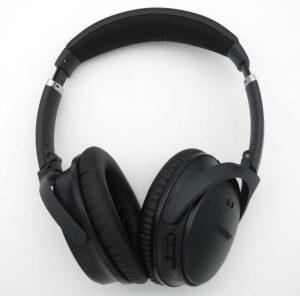
They are comfortable and very effective for low-frequency noise, including airplane and traffic noise, generators, humming machines, and your neighbor’s bass-heavy music.
Depending on the building structure, they may even be able to get rid of most of the footfalls from upstairs neighbors.
I have also tested the QC35 with snoring noise. They can be made into one of the best snoring noise blockers I know of. Note that depending on the snorer, snoring noise may have several peaks in the low-frequency noise range up to 1000 Hz.
In addition, the passive noise isolation of the QC35 is very respectable—effectively muffling even quite loud snoring and most higher-pitched environmental noise. Playing white noise at a moderate volume eliminates the remainder of the snores.
Over-the-headphones aren’t generally designed for side sleepers. I wouldn’t dare using the QC35 with a normal pillow.
But there is a solution: with my favorite u-shaped memory foam travel pillow, I can comfortably lie on the side with them.
I position the pillow so that the opening is at the top of my head. That way, both the headband and the cups don’t get pushed against my head and my chin and cheeks rest on the pillow.
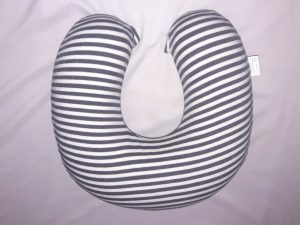
This works surprisingly well with a dense memory foam travel pillow.
The risk is that if I move around a lot, I might wear the headphones out over time or break them. But if I needed to do this to get my night time sleep, I would do it without blinking an eye.
Bose also has noise-cancelling earbuds, the most effective being the QC20.
The Bose Quiet Comfort 20 have a special type of ear tips—StayHear+ ear tips—which don’t have to be pushed in your ear, but sit on the ear canal entrance. These tips make them very comfortable and provide a good seal with no ear pressure. I can wear them for a whole day with no problems whatsoever.
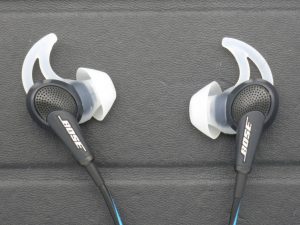
They work fine for back sleepers. Because they are protruding from the ear, they are not ideal for a side sleeper with a standard pillow.
However, they certainly work for me when I sleep on the side with the above-mentioned travel pillow.
Depending on how sensitive your are, a soft memory foam pillow might also do the trick.
The QC20 too are good for eliminating low frequency noise, so if your neighbor’s woofer or traffic rumble is bothering you at night they are very well worth your consideration.
I currently use the QC20 a lot during the day in tropical weather. Unlike over-the-head headphones and earmuffs, they don’t get sweaty.
However, for snoring, speech noise, and environmental noise in general, the QC35 are significantly better.
Besides, while this post is about alternatives to earplugs for sleeping, you can very well wear earplugs underneath the QC35, turning them in an absolute formidable yet comfortable noise blocker.
Sleep headphones
Sleep headphones are headbands with flat, soft speaker inserts. They are designed for both side and back sleepers. These headphones don’t block any noise by themselves. You play white noise using an app for your smart phone to mask moderate noise that keeps you awake.
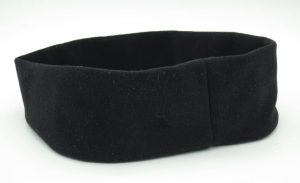 The advantage of these headband headphones for sleeping is that you don’t need to stick anything in your ear.
The advantage of these headband headphones for sleeping is that you don’t need to stick anything in your ear.
If you need to block loud noise, these headphones alone won’t be enough.
However, you can wear earplugs (foam or wax) underneath and play white noise on top of that. This combination makes for a very effective snoring noise blocker.
For this purpose, I recommend SleepPhones Classic and CozyPhones Contour.
Personally, I use my night table white noise machine, usually together with earplugs, more often than sleep headphones. I find that combination more comfortable.
But, if you need to block really loud noise, the combination of sleep headphones and earplugs is slightly more effective.
Sleep earbuds
![]()
Alternatively, play white noise through sleep earbuds to mask moderate noise. My favorite sleep earbuds are made of soft silicone. I find them more comfortable than sleep headphones.
With sleep earbuds you can’t wear earplugs underneath, so you completely rely on the isolation the earbuds provide and noise masking via white noise.
This works well for moderate noise coming from adjacent rooms.
However, sleep earbuds are not ideal for masking a loud snorer and other loud noise. I would have to crank up the white noise volume to the point where the white noise would likely keep me awake.
Passive noise cancelling earmuffs for sleeping
Noise reduction earmuffs are great for blocking noise during the day and protecting your hearing. Students, office workers, and meditators also increasingly use them to increase focus and concentration.
I have done an extensive review of noise cancelling earmuffs. Unfortunately the most effective ones are also the bulkiest, making it almost impossible to sleep with them on the side.
Also, to provide their excellent noise reduction, earmuffs’ clamping force is higher than that of normal headphones, and may be too high for you to sleep.
However, if you are strictly a back sleeper, these earmuffs could work.
If you are a side sleeper, and find the other suggested earplug alternatives either not acceptable or too pricey, some earmuffs do have a slim-enough profile for side sleeping if you use them together with the above-mentioned u-shaped pillow.
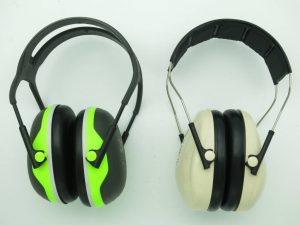
I wouldn’t be able to use muffs with a normal pillow, but I have successfully tried these two while lying on my side with my travel pillow:
The 3M Peltor Optime 95 are economical and have very slim ear cups. Their noise reduction rating (NRR) is 21. They have ear cushions which also fit larger ears.
The 3M Peltor X4A (NRR 27) have equally slim cups but are more effective noise blockers. The downside: the opening of their ear cushions is smaller than the Optime 95’s which can make them uncomfortable for people with large ears.
To improve on their comfort, you can buy 3M gel ear cushions. These cushions work with both the Optime 95 and the X4A, offer a much larger opening for the ears, and are more comfortable.
Unfortunately, these cushions are quite expensive, so it makes sense to try first whether earmuffs for sleeping are for you at all.
Note: The gel ear cushions slightly reduce the noise reduction effectiveness of both earmuffs. They fit, but are not certified for use with these muffs as a hearing protector. Still they are a great hack for sleeping with earmuffs.
You may wonder, how do these compare to the Bose QC35 over-the-head active noise cancelling headphones?
Well, the QC35 are as slim as these low-profile earmuffs and they are a more comfortable. Additionally, they are a lot more effective for low-frequency noise.
If money wasn’t an issue, I’d definitely prefer the QC35 for sleeping.
But still, these earmuffs may offer an economical solution that can help you to fend off sleeplessness.
Conclusion
The combination of foam earplugs plus white noise machine is one of my favorite solutions for night time noise blocking. If I couldn’t use foam anymore, I would keep the sound machine and use wax earplugs.
If you don’t like earplugs for sleeping at all, try one of the alternatives laid out in this post: I would start with a white noise machine all by itself.
For moderate noise, sleep headphones and sleep earbuds together with a white noise app are also good option.
Earmuffs are very effective noise blockers and an option for back sleepers. Their main downsides: they are bulky; they might exert too much pressure for sensitive sleepers. Again, their effectiveness can be augmented with a white noise machine.
The leading active noise cancelling headphones are great for low-frequency noise and a good option for reducing noise in general. They are a lot more comfortable than earmuffs.
I am mostly a side sleeper and don’t want to break the headphones, but I would deploy them if the noise became unbearable.
With foam earplugs underneath, they are probably as good as it gets for eliminating night time noise. (I also highly recommend this combination when traveling on an airplane.)
If you are a back sleeper and willing to spend the cash, active noise cancelling headphones could become your sanctuary.

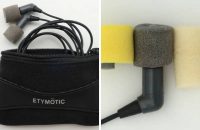
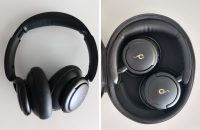
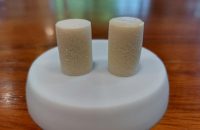
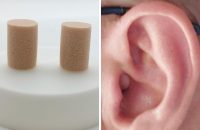
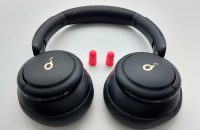
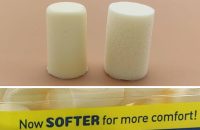
Thanks for this great website!
I don’t know if you can give me any advice, but I am struggling to block/mask the noise of occasional automotive horn honking that wakes me up early in the morning.
I’ve tried foam earplugs with loud white noise and I’ve also tried playing white noise through isolating earbuds.
I use MyNoise and have tried various EQ settings, but the horn sound seems to come through and wake me up. It seems that earplugs actually might be changing the frequency response so that even though all frequencies are attenuated, some are attenuated more than others, leaving the horn noise to stand out even if the decibel level is reduced overall.
Other MyNoise sounds such as Bagpipes sometimes work, but are both annoying in themselves and have periodic quiet passages that leave me vulnerable to an unfortunately timed horn. It’s very hard to experiment, as the horn honking is sporadic.
Hello Louis,
thank you for your feedback. Honking cars can be a real pain.
Horns of normal cars should be in the range of 300 to 500 Hz. The frequencies of truck horns will be substantially lower (125 – 180 Hz according to Wikipedia).
Foam earplugs should work reasonably well for car horns. Wax earplugs are substantially worse in this frequency band.
Optimizing the earplugs’ fit is where I would start:
A deep fit is very important for reducing honking noise; otherwise you might lose 20 dB at 500 Hz. (The noise will appear 4 times as loud as necessary.)
I have recently written a post on fitting foam earplugs and testing their fit. This is where I would start.
Use a fitting noise:
In MyNoise, the app you are using, select band-filtered white noise in the sound generator “White Noise & Co.”
Choose “Band noise, octave 4 – 500 Hz” as a fitting noise while inserting your earplugs to check how well you have inserted them.
Make the noise loud and play it via good speakers. (Smart phone speakers are too small.)
Insert your foam earplugs. As they expand, the noise should get a lot quieter. It should appear as if the noise is getting sucked away.
If it doesn’t, refit the earplugs. If that doesn’t work, choose a different earplug.
Your masking sound:
As a masking noise at night, I would start with the same band filtered noise and also increase the volume of the two adjacent sliders to the left and right. Adjust the remaining sliders for comfort.
Alternatively, try myNoise’s generator “Waterfall Noise,” which can also be equalized.
Again, you need decent speakers for this.
A good white noise machine should work as well.
You likely won’t have to completely mask the honking to remain asleep: significantly reducing the difference between the car horns and the background is what I would be aiming for.
All the best.
Thanks for your detailed and insightful response.
You are very welcome.
In addition to optimizing earplug fit, you could get a pair of earmuffs and wear them on top of the earplugs.
This adds a substantial amount of attenuation for frequencies of up to 1000 Hz.
For this “doubling-up,” low-profile earmuffs like the ones shown in this post are enough.
In terms of comfort, it is a compromise, but it may be worth a try if it helps you to stay asleep.
Perhaps you already have some in your garage.
Good noise cancelling headphones can also be used for doubling-up and are more comfortable.
They should perform better for low-frequency truck horns. For normal automobile horns they help as well but won’t outperform the muffs.
So right on the earmuffs, the better you relax, the more comfy they are on your ears. Gel ear-seals (HY 80) and sheepskin shearling fur make them super comfortable.
Thank you Helmut – this has been very helpful to me and the best treatment of the subject I have seen.
Just to be sure – the noise canceling earphones recognise and attempt to cancel snoring, yes?
Hello David,
Many thanks for your feedback.
If you are referring to the QC20, they work for me against moderate, but not loud snoring noise.
You can improve on that by playing louder white noise through the QC20, but the over-the-ear QC35 are a lot more effective against loud snoring.
And yes, the microphones pick up the snoring noise and the electronics respond to it, so it is not just passive noise isolation.
Take a look at this post, which goes more into detail: https://noisyworld.org/noise-cancelling-headphones-snoring/
All the best.
Hi. My husband is a really loud snorer and I am a really light sleeper. Currently I will just go in another room. This is a problem though when we go away and not great for our marriage! I have in ear buds and have had some custom made ones made up. Problem is I had ear problems as a child and according to the dr have a lot of scarring in my ears and they become easily inflamed. This means I end up waking up with sore ears and can only usually bear them
In for one night. Any advice would be grateful.
Hello Sarah,
Wax and silicon putty earplugs don’t go into the ear canal (they are malleable and only seal the entrance) and might hence be easier to wear. However, they are less effective than foam earplugs; all by themselves, they likely won’t reduce your husband’s loud snoring enough for you to be comfortable.
You could use headband sleep headphones (see above) (or perhaps a pillow speaker) in addition to wax/silicone putty earplugs and play white noise. That would improve the situation and might be worth a try.
Other than that, if you can’t have anything in your ear, you need something over your ear.
Over-the-ear noise cancelling headphones are an option if you are a back sleeper. Take a look at the article “Do noise cancelling headphones work for snoring?” for more details.
A budget solution for a back sleeper are hearing protection earmuffs. If you want to try them, I would go for earmuffs with built-in speakers, such as the Worktunes Connect (link to my review of them), so that you can again play white noise if necessary.
However, they exert significantly more headband force than headphones. Some people can sleep with them while others find the pressure too strong for comfort.
(Btw, there are special earmuffs for sleeping and I have tried a pair; they didn’t do nearly enough against snoring.)
I hope this helps a bit.
All the best.